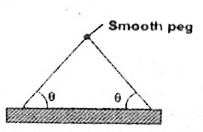A
B
C
D
Text Solution
Verified by Experts
The correct Answer is:
|
Topper's Solved these Questions
LAWS OF MOTION
FIITJEE|Exercise COMPREHENSION - I|6 VideosView PlaylistLAWS OF MOTION
FIITJEE|Exercise COMPREHENSION - II|5 VideosView PlaylistLAWS OF MOTION
FIITJEE|Exercise SOLVED PROBLEMS (SUBJECTIVE)|11 VideosView PlaylistKINEMATICS
FIITJEE|Exercise NUMERICAL BASED QUESTIONS DECIMAL TYPE|5 VideosView PlaylistMAGNETIC
FIITJEE|Exercise Numerical Based Type|2 VideosView Playlist
Similar Questions
Explore conceptually related problems
Knowledge Check
A
B
C
D
Submit
A
B
C
D
Submit
Similar Questions
Explore conceptually related problems
FIITJEE-LAWS OF MOTION-SOLVED PROBLEMS (OBJECTIVE)
- Three blocks of masses 3 kg, 6 kg and 1 kg are connected by a string p...
05:31
|
Play - A man of mass m=60kg is standing on weighing machine fixed on a triang...
02:48
|
Play - A U-shaped smooth wire has a semi-circular bending between A and B as ...
02:37
|
Play - A massive platform of mass M is moving with speed v=6ms^(-1) At t = 0,...
06:11
|
Play - An iron nail is dropped from a height h on the level of a sand bed. If...
07:22
|
Play - A uniform chain of mass m and length I is kept on the table with a pa...
07:04
|
Play - In the given figure, the wedge is acted upon by a constant horizontal ...
09:05
|
Play - A pendulum is hanging from the ceiling of a cage. If the cage moves up...
11:22
|
Play - In fig. the block of mass M is at rest on the floor . At what accelera...
02:45
|
Play - A block pulley arrangement is shown in the figure. If f(1) and f(2) re...
07:40
|
Play - Three identical ideal springs, each of spring constant K = 2000 N/m ar...
Text Solution
|
Play - A car of mass m = 1000 kg is moving with constant speed v = 10 m/s on ...
Text Solution
|
Play - A block of mass m is supported by a string passing through a smooth pe...
01:49
|
Play - A person is sitting in a travelling train and facing the engine. He to...
01:45
|
Play - An amusement park ride called "The spinning Terror" is a large vertica...
Text Solution
|
Playing Now - Two blocks A and B of equal mass m are connected through a massless st...
08:49
|
Play - A particle moves along the X-axis as x=u(t-2s)=at(t-2)^2.
02:49
|
Play
